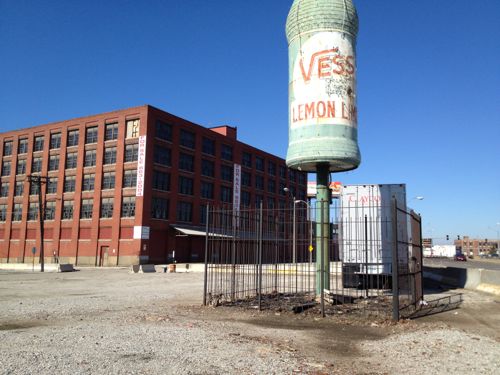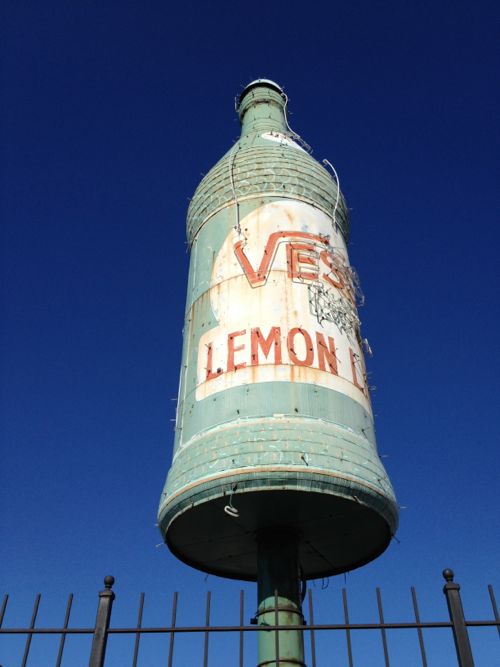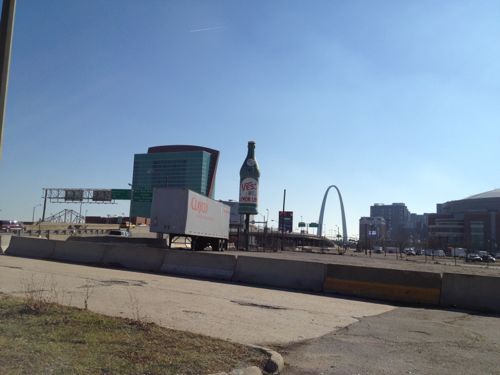The Bottle Undistrict
The soft drink 7-Up was once marketed as the uncola. For years now people have been trying to market the vacant land and a vacant warehouse north of the Edwards Jones Dome as The Bottle District. The first post where I mentioned The Bottle District was in August 2005 (Thoughts on St. Louis’ Proposed Riverfront Makeover, Lid Over I-70 and Mississippi River Bridge).
The Bottle District is a six-block area north of Downtown St. Louis, Missouri that is being redeveloped as a mixed-use entertainment and residential district. The area is located north of the city’s convention center and west of Laclede’s Landing.
The district is located in what was once known as the Kerry Patch neighborhood of the city, which was home to thousands of Irish immigrants in the 19th Century. The neighborhood gradually became more industrial in nature. In the 1920s this area was famous for animal stockyards and bottling companies.
McGuire Moving and Storage Company, a longtime business located in the area, announced plans for redeveloping the district as an entertainment destination in 2004. Noted architect Daniel Libeskind was hired to design the district. The Ghazi Company of Charlotte, North Carolina is the co-developer of the Bottle District.
The first phase of the redevelopment is scheduled to open in 2007. A groundbreaking ceremony was held on September 27, 2005. The first phase will include a Rawlings Sports museum, a Grand Prix Speedways kart-racing center, a boutique bowling alley, 250 residential units, and several restaurants. The first phase of the development is anticipated to cost $290 million and is being funded in part by $51.3 million in tax increment financing.
Several explanations for the origin of the name of the Bottle District have been given. It has been suggested that the name honors the longstanding connection between St. Louis and the brewing and bottling industries. Others have suggested that the name comes from bottles found buried on the property, or the many broken bottles found in the neighborhood. Finally, the site is noted for a decades old, 34-foot-tall (10 m) advertisement for Vess Soda, shaped like a bottle, which the developers intend to restore during the redevelopment. (Wikipedia)
Here we are years later and this district remains anything but a district. To me it’s The Bottle Undistrict.



The problem here is this has been developer-driven planning. Big picture urban planning would have looked at how to develop this land and connect it to the west, the former Cochran public housing project, now the nice mixed-income Cambridge Heights neighborhood and renovated Neighborhood Gardens apartment development from 1935. Developers rarely think beyond the borders of their property, that takes municipal planning to knit together private parcels into a cohesive city.
We should be planning now for when the new I-70 bridge opens to the north, allowing the replacement of the highway lanes with a high volume boulevard instead. This district could then front onto the boulevard and more easily connect to the east. But our leadership doesn’t get it, to them the 1970 way is just fine.
– Steve Patterson
Please clarify, who is the “We” in “We should be planning now for when the new I-70 bridge opens to the north”? Is it the paid city planning staff? The aldermen in the affected area? The entire Board of Aldermen? The Mayor? The residents of the area? Residents from outside the area? Students at SLU and/or Wash. U? The ULI? Potential developers? MoDOT? The existing property owners? Trailnet? HUD? NPS? Paul McKee?
ALL of these should, and most do, have an interest in this area. Who should lead the effort(s)? Who should be the arbiter, the decider? Who resolves the inevitable conflicts in visions and agendas? While I understand your frustration with “developer-driven planning”, I’m equally frustrated with planning efforts that result in idealistic, at times, pie-in-the-sky concepts, that result in plans that just end up sitting on a shelf somewhere, gathering dust. For any plan to be truly effective, it needs to be implemented. And to get people engaged, and to keep them engaged, they need to see tangible results for their efforts.
Please clarify, who is the “We” in “We should be planning now for when the new I-70 bridge opens to the north”? Is it the paid city planning staff? The aldermen in the affected area? The entire Board of Aldermen? The Mayor? The residents of the area? Residents from outside the area? Students at SLU and/or Wash. U? The ULI? Potential developers? MoDOT? The existing property owners? Trailnet? HUD? NPS? Paul McKee?
ALL of these should, and most do, have an interest in this area. Who should lead the effort(s)? Who should be the arbiter, the decider? Who resolves the inevitable conflicts in visions and agendas? While I understand your frustration with “developer-driven planning”, I’m equally frustrated with planning efforts that result in idealistic, at times, pie-in-the-sky concepts, that result in plans that just end up sitting on a shelf somewhere, gathering dust. For any plan to be truly effective, it needs to be implemented. And to get people engaged, and to keep them engaged, they need to see tangible results for their efforts.
The “we” is the parties you listed — the community.
I agree, we should all be a part of the process, but who will LEAD the process? I don’t see the city being very motivated, so I’m guessing that Paul Mckee may end up by default, since he has both the motivation and the resources.
JZ71 brings up a good point. If anything is going to happen here (including removal of i-70), it’s going to more than likely need Mckee’s fingerprint on it (as sad as that is). Steve, have you ever had a discussion with Mr. Mckee? It could be quite beneficial. Offer him an interview for the blog: he possibly gets the support of your readership and maybe you would be able to open his eyes to some areas for urban revitalization that would benefit his development plans (i.e, removal of the elevated lanes to connect his Bottle District to Laclede’s landing).
I’ve not talked to Paul McKee in a few years. St. Louis’ continued failure is to abandon it’s role as the big-picture planner, the one to connect the dots between different private developments.
Then how do we change this? Elect more people like Scott Ogilvie and Antonio French? Empower citizens and city staff? Yes, but the biggest challenge remains demand. We’re a city that continues to lose population and jobs. Why build something, anything new, especially somthing urban, mixed use, higher density? I’ve seen what’s being built – U-Gas, CVS, QT, Dunkin Doughnuts, the occassional small strip mall – and there’s little that “better planning” would improve. And the biggest project in the works in my part of the world would be Shrewsbury’s plans to replace a fading shopping center with a Walmart – the only “citizen involvement” has been the NIMBY kind, with the city focused on sales tax revenues – inertia at its worst . . . .
We’ve continued to build and rebuild in the past six decades, despite population loss. During the “urban renewal” era the rebuilding accelerated population loss.
We need to elect enough aldermen to change how development gets done. They would perhaps create 4-6 planning districts to cover the entire city, these would intentionally ignore ward boundaries. Corridors, like Natural Bridge, would be studied and development guidelines created and implemented through a zoning overlay or through new form-based zoning.
The “we” is the parties you listed — the community.
Well Vessville maynot have come to frutition, there are a lot of issues out of the hand of the developer i.e. the tanking of the economy. I think Ballpark non-village would have been a better use of your time.
Well Vessville maynot have come to frutition, there are a lot of issues out of the hand of the developer i.e. the tanking of the economy. I think Ballpark non-village would have been a better use of your time.
The first plan was announced in 2004 and the first phase was to open in 2007.
Economic realities never seem to apply in this section of cyberspace.
The economy was riding a big bubble in 2004-07.
And with the clarity of 20/20 hindsight, the only really viable part of Phase One would have been the housing and, possibly, some of the restaurants. The “Rawlings Sports museum, a Grand Prix Speedways kart-racing center [and] a boutique bowling alley” all would have likely fared poorly, even if they had managed to have been built.
flamingo bowling came in around that time, or shortly after, and it seems to be doing well.
Location, location, location – Flaming Bowl works because of where it’s located. The Bottle District would’ve been a new entertainment venue, along the lines of BPV, and given the timing (immediately before the recession hit), odds are good that there wouldn’t have been enough critical mass to sustain another entertainment venue in/near downtown.
Agreed on all parts. The large-scale developer-driven approach just creates islands. These projects can’t successfully find tenants (business or residential) because it exists as a separate island in an otherwise “undesirable” neighborhood. Meanwhile, the neighborhood doesn’t embrace it for the same reason.
Removing I-70, while certainly a risky move, is the right one. The future of the city’s growth is the north side. But in order to make that happen, we need bold, unified planning on downtown’s northern edge to spur the start. Bottle District, Near North Riverfront, Old North, the Trestle Project, the new Bridge…there’s a lot going on all ready (or at least planned). For a true success, each project needs to be done with respect and collaboration with the other.
Agreed on all parts. The large-scale developer-driven approach just creates islands. These projects can’t successfully find tenants (business or residential) because it exists as a separate island in an otherwise “undesirable” neighborhood. Meanwhile, the neighborhood doesn’t embrace it for the same reason.
Removing I-70, while certainly a risky move, is the right one. The future of the city’s growth is the north side. But in order to make that happen, we need bold, unified planning on downtown’s northern edge to spur the start. Bottle District, Near North Riverfront, Old North, the Trestle Project, the new Bridge…there’s a lot going on all ready (or at least planned). For a true success, each project needs to be done with respect and collaboration with the other.
The first plan was announced in 2004 and the first phase was to open in 2007.
I agree, we should all be a part of the process, but who will LEAD the process? I don’t see the city being very motivated, so I’m guessing that Paul Mckee may end up by default, since he has both the motivation and the resources.
It’s not an original idea, but the most successful redevelopment has been organic and not planned. It is when cheap rents in older, undesirable buildings allow for innovations in restaurants, boutiques, clubs and housing units at happend on Washington and now in mid-town alley. Large scale development shouldn’t precede overall growth in the region. It doesn’t create growth. Â
It’s not an original idea, but the most successful redevelopment has been organic and not planned. It is when cheap rents in older, undesirable buildings allow for innovations in restaurants, boutiques, clubs and housing units at happend on Washington and now in mid-town alley. Large scale development shouldn’t precede overall growth in the region. It doesn’t create growth.
Tax credits have been a big part of the organic growth of Wash Avenue and Midtown Alley
The two biggest impediments to organic redevelopment are a lack of capital (banks aren’t lending) and a lack of demand (there’s already a lot of vacant property on the market, both for rent and for sale). Large scale development isn’t inherently bad, it’s just when it happens in a vaccuum, is poorly planned and/or poorly constructed. I’d argue that some of the larger developments around Denver (Stapleton, Lowry, Belmont) are both better than their surrounding neighborhoods, and that their successes have encouraged successful, smaller-scale projects nearby. I’d also posit that the biggest challenge for “good design” in the St. Louis region remains the automobile. Much of the city was built when the primary form of transportation was the streetcar, and the built environment reflected that people walked. Today, the city is being rebuilt for people who drive, and we haven’t developed the critical mass to make denser, mixed-use projects financially viable.
 Economic realities never seem to apply in this section of cyberspace.
JZ71 brings up a good point. If anything is going to happen here (including removal of i-70), it’s going to more than likely need Mckee’s fingerprint on it (as sad as that is). Steve, have you ever had a discussion with Mr. Mckee? It could be quite beneficial. Offer him an interview for the blog: he possibly gets the support of your readership and maybe you would be able to open his eyes to some areas for urban revitalization that would benefit his development plans (i.e, removal of the elevated lanes to connect his Bottle District to Laclede’s landing).
The economy was riding a big bubble in 2004-07.
I’ve not talked to Paul McKee in a few years. St. Louis’ continued failure is to abandon it’s role as the big-picture planner, the one to connect the dots between different private developments.
Tax credits have been a big part of the organic growth of Wash Avenue and Midtown AlleyÂ
Then how do we change this?  Elect more people like Scott Ogilvie and Antonio French? Empower citizens and city staff? Yes, but the biggest challenge remains demand. We’re a city that continues to lose population and jobs. Why build something, anything new, especially somthing urban, mixed use, higher density? I’ve seen what’s being built – U-Gas, CVS, QT, Dunkin Doughnuts, the occassional small strip mall – and there’s little that “better planning” would improve. And the biggest project in the works in my part of the world would be Shrewsbury’s plans to replace a fading shopping center with a Walmart – the only “citizen involvement” has been the NIMBY kind, with the city focused on sales tax revenues - inertia at its worst . . . .
The two biggest impediments to organic redevelopment are a lack of capital (banks aren’t lending) and a lack of demand (there’s already a lot of vacant property on the market, both for rent and for sale). Large scale development isn’t inherently bad, it’s just when it happens in a vaccuum, is poorly planned and/or poorly constructed. I’d argue that some of the larger developments around Denver (Stapleton, Lowry, Belmont) are both better than their surrounding neighborhoods, and that their successes have encouraged successful, smaller-scale projects nearby. I’d also posit that the biggest challenge for “good design” in the St. Louis region remains the automobile. Much of the city was built when the primary form of transportation was the streetcar, and the built environment reflected that people walked. Today, the city is being rebuilt for people who drive, and we haven’t developed the critical mass to make denser, mixed-use projects financially viable.
We’ve continued to build and rebuild in the past six decades, despite population loss. During the “urban renewal” era the rebuilding accelerated population loss.
We need to elect enough aldermen to change how development gets done. They would perhaps create 4-6 planning districts to cover the entire city, these would intentionally ignore ward boundaries. Corridors, like Natural Bridge, would be studied and development guidelines created and implemented through a zoning overlay or through new form-based zoning.
And with the clarity of 20/20 hindsight, the only really viable part of Phase One would have been the housing and, possibly, some of the restaurants. The “Rawlings Sports museum, a Grand Prix Speedways kart-racing center [and] a boutique bowling alley” all would have likely fared poorly, even if they had managed to have been built.
flamingo bowling came in around that time, or shortly after, and it seems to be doing well.
Location, location, location – Flaming Bowl works because of where it’s located. The Bottle District would’ve been a new entertainment venue, along the lines of BPV, and given the timing (immediately before the recession hit), odds are good that there wouldn’t have been enough critical mass to sustain another entertainment venue in/near downtown.